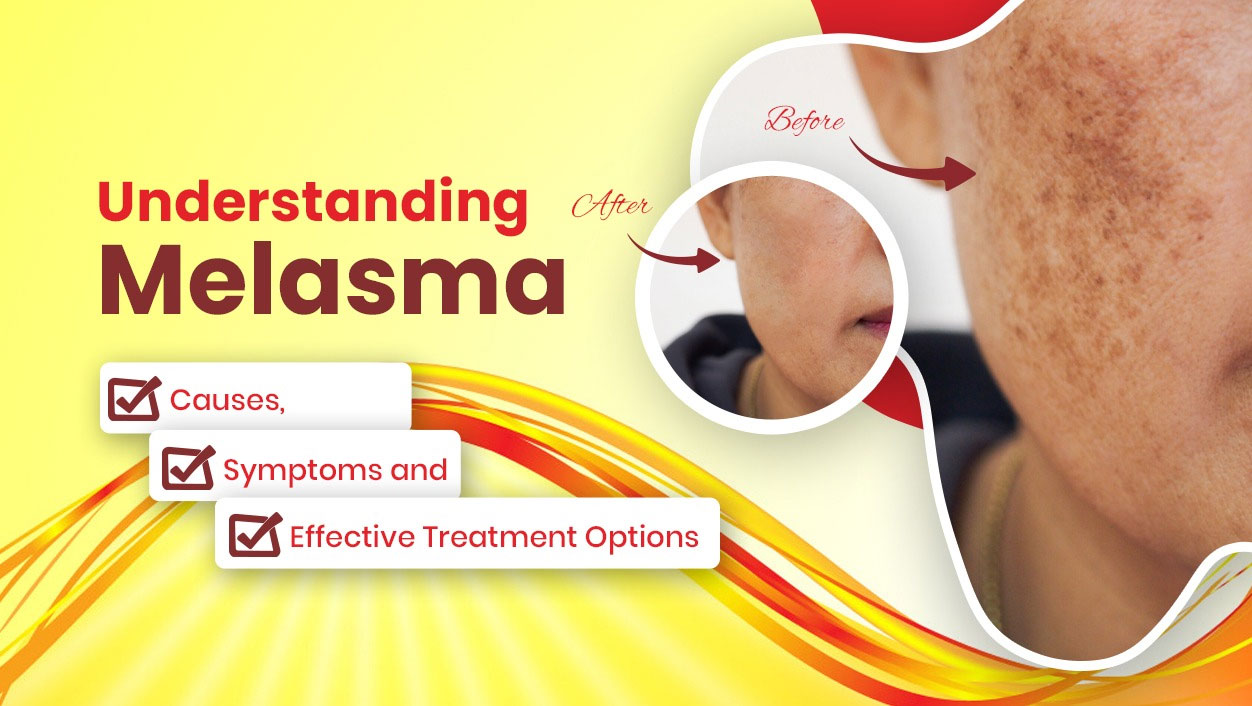Blog Details

Understanding Melasma Causes, Symptoms and Effective Treatment Options
Melasma is a common skin condition that causes dark, patchy discoloration, often on the face. While it’s completely harmless, it can be persistent and influenced by factors like sun exposure, hormones, genetics, and skin inflammation.
Many people notice melasma during pregnancy or with hormonal treatments, but it can also appear due to lifestyle and environmental triggers.
The good News?
With the right approach, melasma can be managed effectively. From protective skincare to advanced dermatological treatments, understanding your options is key to maintaining an even skin tone.
In this guide, we’ll explore what causes melasma, how it can be treated, and expert-approved solutions for long-term skin health.
What is melasma?
Melasma is a chronic skin condition characterized by brown, gray or blue-toned patches, typically appearing on areas exposed to the sun, such as cheeks, forehead, nose, upper lip, and jawlines.
The condition is more common in women (especially during pregnancy) and individuals with darker skin tones. It is often triggered by hormonal fluctuations and UV exposure.
What Causes Melasma?
Melasma develops when melanocytes (pigment-producing cells) become overactive, leading to excess melanin production. Several factors can contribute to this:
1. Hormonal Changes
● Pregnancy: Often called the “mask of pregnancy”, melasma is triggered by increased estrogen and progesterone levels.
● Birth Control Pills & Hormone Therapy: These can stimulate melanocytes, leading to pigmentation.
2. Sun Exposure: UV rays are the biggest culprit. They stimulate melanin production, causing new patches and darkening existing ones.
3. Genetic Predisposition: If a parent or sibling has melasma, the chances of developing it are higher.
4. Skincare & Cosmetic Products: Certain products containing fragrances, harsh chemicals or irritants may trigger melasma by weakening the skin barrier.
5. Heat & Infrared Light: Apart from UV rays, heat from cooking, saunas and even laptops can worsen melasma.
How is Melasma Diagnosed?
A qualified professional (Dermatologist /Plastic surgeon) can diagnose melasma through visual examination, but additional tests may be used for confirmation:
Wood’s Lamp Examination: This special UV light helps determine how deep the pigmentation is.
Dermatoscopy: Magnified skin analysis to differentiate melasma from other pigmentary disorders.
Skin Biopsy (Rare Cases): If the diagnosis is uncertain, a small skin sample may be analyzed.
Effective Treatment Options for Melasma
Managing melasma requires a comprehensive approach that focuses on reducing pigmentation and preventing recurrence. Sun protection is the first and most crucial step, as UV exposure can trigger and worsen melasma.
Wearing broad-spectrum sunscreen, using protective clothing and minimizing sun exposure during peak hours can significantly help in controlling the condition.
Beyond sun protection, lifestyle modifications play an essential role. Maintaining a healthy diet, managing stress, balancing hormones and avoiding skin irritants can help prevent flare-ups.
Additionally, gentle skincare routines with dermatologist or surgeon-recommended products may support skin health and gradually improve pigmentation.
Advanced Treatment Options for Melasma
For those seeking more noticeable improvement, advanced cosmetic procedures can help reduce melasma and restore an even skin tone. Treatments such as chemical peels, laser therapy and microneedling work by targeting excess pigmentation and promoting skin renewal.
● Chemical Peels: These involve applying a mild acid solution to exfoliate the skin, gradually reducing dark patches and improving overall skin texture.
● Laser Therapy: Specialized lasers target melanin deposits in the skin, breaking them down without damaging surrounding tissue. This method is effective but requires careful skin assessment before treatment.
● Microneedling: This procedure stimulates collagen production by creating tiny micro-injuries in the skin, helping to fade pigmentation over time while enhancing skin texture and elasticity.
While these treatments can be effective, results vary based on skin type and severity of melasma. A professional consultation can help determine the most suitable option for long-term management.
Frequently Asked Questions About Melasma
1. Can Melasma Be Cured Completely?
Melasma is a chronic skin condition, meaning it can be managed but not always cured completely. With the right treatment—ranging from lifestyle adjustments to advanced cosmetic procedures—its appearance can be significantly reduced. However, triggers like sun exposure, hormonal changes and certain medications can cause recurrence. Consistent skin care and sun protection play a key role in long-term control.
2. When Should You Consult a Specialist for Melasma?
If your melasma is persistent, worsening or affecting your confidence, it’s best to seek professional advice. A specialist can assess the severity, identify potential triggers and recommend personalized treatment options, including prescription creams, chemical peels, or laser treatments. Early consultation ensures better outcomes.
3. Can Melasma Go Away on Its Own?
In some cases, melasma may fade on its own, especially if it's triggered by pregnancy (known as the "mask of pregnancy") or birth control pills and the underlying hormonal imbalance resolves. However, for many people, melasma lingers and requires treatment to improve.
4. Are Home Remedies Effective for Melasma?
Some home remedies, like aloe vera, turmeric or apple cider vinegar, may provide mild benefits, but they are not scientifically proven to eliminate melasma. Professional treatments are more effective in reducing pigmentation. Always consult a specialist before trying home remedies to avoid skin irritation.
5. Can Melasma Turn Into Skin Cancer?
No, melasma itself is not a form of skin cancer, nor does it increase the risk of developing cancer. However, any sudden skin changes, including dark patches that evolve in shape or texture, should be evaluated by a specialist to rule out other conditions.
6. Is Laser Treatment Safe for All Skin Types?
Laser therapy can be effective for melasma, but it is not suitable for everyone. Certain skin types, especially darker tones, may be at higher risk of hyperpigmentation or scarring. A specialist will determine whether laser treatment is appropriate based on your skin type and melasma severity.
7. Can Melasma Be Prevented?
While melasma cannot always be prevented, you can reduce the risk by:
● Sunscreen needs to be applied on regular intervals as advised
● Using wide-brimmed hats and sunglasses for extra protection
● Avoiding excessive heat and direct sun exposure
● Managing hormonal triggers (e.g., discussing birth control options with a doctor)
● Following a consistent skincare routine with brightening and protective ingredients
Take away
Melasma is a manageable condition with the right approach. If you're struggling with persistent pigmentation, consulting a specialist is the best way to find a treatment plan tailored to your needs.
offers advanced options like chemical peels, lasers and microneedling to help reduce hyperpigmentation caused by melasma and restore a radiant complexion.












